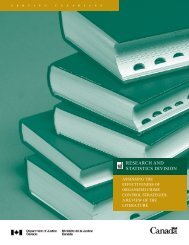National Threat Assessment 2008. Organised Crime - Politie
National Threat Assessment 2008. Organised Crime - Politie
National Threat Assessment 2008. Organised Crime - Politie
Create successful ePaper yourself
Turn your PDF publications into a flip-book with our unique Google optimized e-Paper software.
2.7 Illegal immigrant smuggling 30<br />
2.7.1 Introduction and scope<br />
Since the amendment of Section 197a of the Penal Code on 1 January 2005,<br />
smuggling of illegal immigrants has been defined as the provision of assistance<br />
in gaining illegal access to the Netherlands, the provision of assistance in illegal<br />
travel through the Netherlands and the profit‐motivated provision of assistance<br />
in illegal residence in the Netherlands. People can decide to move to a different<br />
country for various reasons. If the journey to the destination country cannot be<br />
undertaken in a legal manner, for example, due to a ban on leaving the person’s<br />
home country or a restrictive admission policy in the destination country, the<br />
migrant may contact smugglers for help. Smuggling of illegal immigrants can<br />
therefore be described as an illegal services market. The smugglers have the<br />
knowledge and means required to organise the journey at a price. People who<br />
use these services may attempt to obtain legal status in the destination country<br />
after their arrival, or they will have to accept life as an illegal alien.<br />
The law makes a distinction between smuggling of illegal immigrants and human<br />
trafficking. The former involves illegal migration on a voluntary basis, whilst<br />
human trafficking involves a violation of personal freedom. In practice it is not<br />
always easy to distinguish between these two offences. Especially problematic are<br />
situations where smuggled people start working at their destination after they<br />
arrive and are exploited in relation to their work. If the smuggler had intended<br />
from the start to exploit the smuggled person, then the entire process – including<br />
everything about the person’s actual migration – will probably be considered to<br />
constitute human trafficking. If the smuggler was not involved with whatever<br />
happened to the smuggled person after the person arrived in the destination<br />
country, the illegal migration will usually be considered to constitute smuggling of<br />
illegal immigrants . In this example we simply stated that the smuggled persons<br />
were victims of exploitation; real life, however, is not as clear-cut. It is often<br />
difficult to establish whether illegal migrants who work in bad circumstances in<br />
the catering sector are victims of socio-economic exploitation or whether they are<br />
performing illegal work that is badly paid. Nevertheless, this distinction determines<br />
whether this is a case of human trafficking or smuggling of illegal immigrants.<br />
30<br />
This section is based on a report prepared in part for NTA 2008: Dienst <strong>National</strong>e Recherche<br />
(DNR), <strong>2008.</strong> Mensensmokkel. Deelrapport Criminaliteitsbeeldanalyse 2007. Korps landelijke<br />
politiediensten (Netherlands Police Agency), DNR (<strong>National</strong> <strong>Crime</strong> Squad), Driebergen<br />
(confidential). The author of this report is M. Soudijn. The information from this report was<br />
included with a view to qualifying the threat level of the criminal phenomenon. This qualification<br />
and a summary of the arguments can be found in the final section.<br />
74 <strong>National</strong> <strong>Threat</strong> <strong>Assessment</strong> 2008 – <strong>Organised</strong> crime








